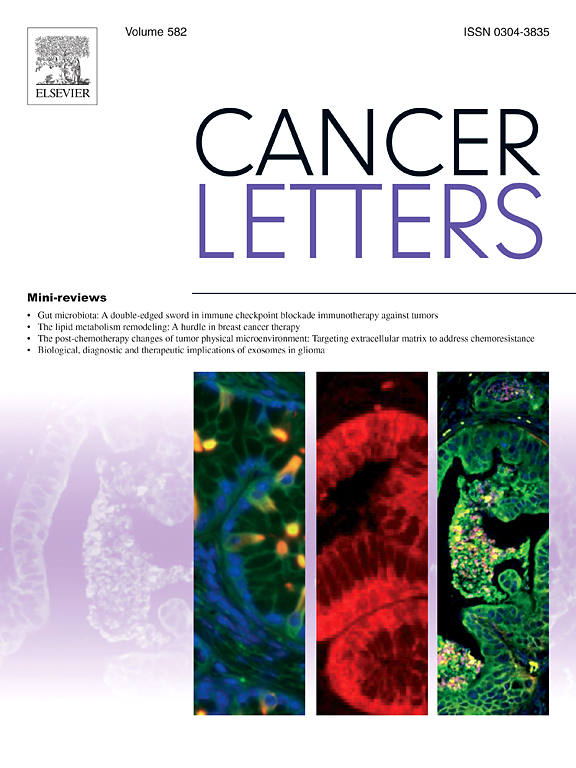Multiplex characterization of circulating tumor cells from ductal carcinoma in situ patients suggests early tumor dissemination
IF 9.1
1区 医学
Q1 ONCOLOGY
引用次数: 0
Abstract
While ducal carcinoma in situ (DCIS) is considered to be pre-invasive, some patients will develop metastatic disease after a long disease-free interval. The prevailing dogma posits that invasive local recurrence is the source of subsequent metastasis, and thus the goal of DCIS therapy is the prevention of local recurrence. Recently, this paradigm has been called into question by the observation that some women develop metastatic disease in the absence of local recurrence or even following bilateral mastectomies, suggesting early cancer dissemination in some patients. If the presence of circulating tumor cells (CTCs) can be verified on some patients with pure DCIS, then dissemination may be occurring earlier than previously thought, suggesting that these patients might require additional monitoring or treatment. Here, we present a workflow to isolate and characterize CTCs from DCIS patients. Using a high throughput size based inertial focusing microfluidic device, the Labyrinth, we isolated and identified CTCs in 66.6 % (12/18) of DCIS patients with an average of 1.337 CTCs per five mL. Immunofluorescence staining and single cell qPCR of CTCs reveal mesenchymal characteristics of the cells that may contribute to their ability to migrate and metastasize. Preliminary targeted DNA sequencing revealed single nucleotide variations previously found in DCIS samples. Overall, this data supports the hypothesis that cancer dissemination is occurring in a subset of DCIS patients earlier than previously thought. Additionally, the molecular characterization of CTC in DCIS patients may provide important information on their biological characteristics and associated clinical behavior.
导管原位癌患者循环肿瘤细胞的多重特征提示肿瘤早期播散
虽然导管原位癌(DCIS)被认为是侵袭前的,但一些患者会在长时间无病间隔后发展为转移性疾病。主流观点认为浸润性局部复发是随后转移的来源,因此DCIS治疗的目标是预防局部复发。最近,这种模式受到了质疑,因为观察到一些妇女在没有局部复发的情况下甚至在双侧乳房切除术后发生转移性疾病,这表明一些患者的早期癌症扩散。如果可以在一些单纯DCIS患者身上证实循环肿瘤细胞(ctc)的存在,那么传播可能比以前认为的更早发生,这表明这些患者可能需要额外的监测或治疗。在这里,我们提出了一种从DCIS患者中分离和表征ctc的工作流程。使用基于高通量大小的惯性聚焦微流控装置Labyrinth,我们在67.6%(12/18)的DCIS患者中分离并鉴定了ctc,平均每5 mL有1.337个ctc。ctc的免疫荧光染色和单细胞qPCR揭示了细胞的间质特征,这可能有助于它们迁移和转移的能力。初步靶向DNA测序揭示了先前在DCIS样本中发现的单核苷酸变异。总的来说,这些数据支持了一种假设,即癌症传播发生在DCIS患者的一个子集中,比以前认为的要早。此外,DCIS患者CTC的分子特征可能为其生物学特征和相关临床行为提供重要信息。
本文章由计算机程序翻译,如有差异,请以英文原文为准。
求助全文
约1分钟内获得全文
求助全文
来源期刊

Cancer letters
医学-肿瘤学
CiteScore
17.70
自引率
2.10%
发文量
427
审稿时长
15 days
期刊介绍:
Cancer Letters is a reputable international journal that serves as a platform for significant and original contributions in cancer research. The journal welcomes both full-length articles and Mini Reviews in the wide-ranging field of basic and translational oncology. Furthermore, it frequently presents Special Issues that shed light on current and topical areas in cancer research.
Cancer Letters is highly interested in various fundamental aspects that can cater to a diverse readership. These areas include the molecular genetics and cell biology of cancer, radiation biology, molecular pathology, hormones and cancer, viral oncology, metastasis, and chemoprevention. The journal actively focuses on experimental therapeutics, particularly the advancement of targeted therapies for personalized cancer medicine, such as metronomic chemotherapy.
By publishing groundbreaking research and promoting advancements in cancer treatments, Cancer Letters aims to actively contribute to the fight against cancer and the improvement of patient outcomes.
 求助内容:
求助内容: 应助结果提醒方式:
应助结果提醒方式:


